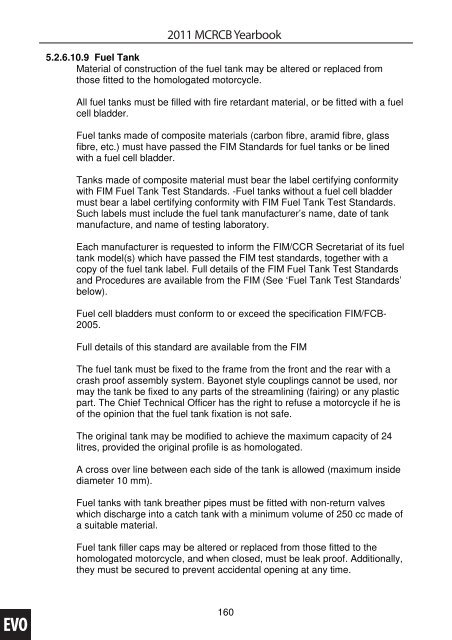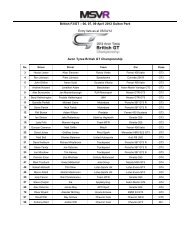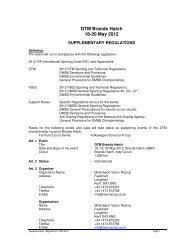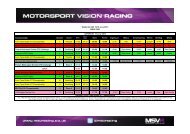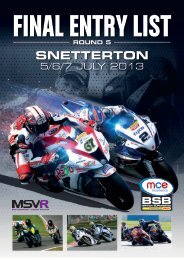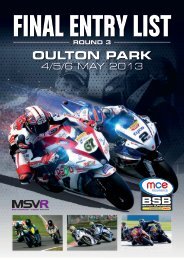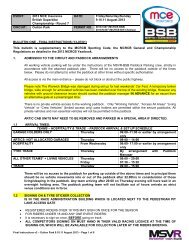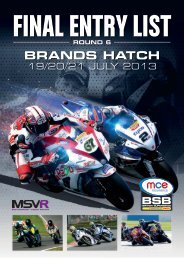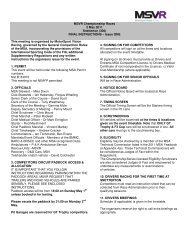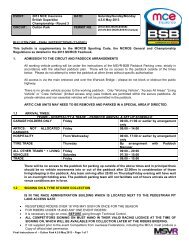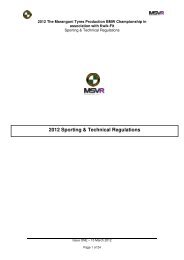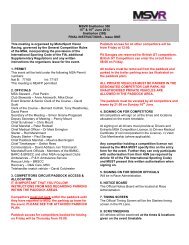E - MotorSport Vision Racing
E - MotorSport Vision Racing
E - MotorSport Vision Racing
You also want an ePaper? Increase the reach of your titles
YUMPU automatically turns print PDFs into web optimized ePapers that Google loves.
2011 MCRCB Yearbook<br />
5.2.6.10.9 Fuel Tank<br />
Material of construction of the fuel tank may be altered or replaced from<br />
those fitted to the homologated motorcycle.<br />
All fuel tanks must be filled with fire retardant material, or be fitted with a fuel<br />
cell bladder.<br />
Fuel tanks made of composite materials (carbon fibre, aramid fibre, glass<br />
fibre, etc.) must have passed the FIM Standards for fuel tanks or be lined<br />
with a fuel cell bladder.<br />
Tanks made of composite material must bear the label certifying conformity<br />
with FIM Fuel Tank Test Standards. -Fuel tanks without a fuel cell bladder<br />
must bear a label certifying conformity with FIM Fuel Tank Test Standards.<br />
Such labels must include the fuel tank manufacturer’s name, date of tank<br />
manufacture, and name of testing laboratory.<br />
Each manufacturer is requested to inform the FIM/CCR Secretariat of its fuel<br />
tank model(s) which have passed the FIM test standards, together with a<br />
copy of the fuel tank label. Full details of the FIM Fuel Tank Test Standards<br />
and Procedures are available from the FIM (See ‘Fuel Tank Test Standards’<br />
below).<br />
Fuel cell bladders must conform to or exceed the specification FIM/FCB-<br />
2005.<br />
Full details of this standard are available from the FIM<br />
The fuel tank must be fixed to the frame from the front and the rear with a<br />
crash proof assembly system. Bayonet style couplings cannot be used, nor<br />
may the tank be fixed to any parts of the streamlining (fairing) or any plastic<br />
part. The Chief Technical Officer has the right to refuse a motorcycle if he is<br />
of the opinion that the fuel tank fixation is not safe.<br />
The original tank may be modified to achieve the maximum capacity of 24<br />
litres, provided the original profile is as homologated.<br />
A cross over line between each side of the tank is allowed (maximum inside<br />
diameter 10 mm).<br />
Fuel tanks with tank breather pipes must be fitted with non-return valves<br />
which discharge into a catch tank with a minimum volume of 250 cc made of<br />
a suitable material.<br />
Fuel tank filler caps may be altered or replaced from those fitted to the<br />
homologated motorcycle, and when closed, must be leak proof. Additionally,<br />
they must be secured to prevent accidental opening at any time.<br />
EVO<br />
160


